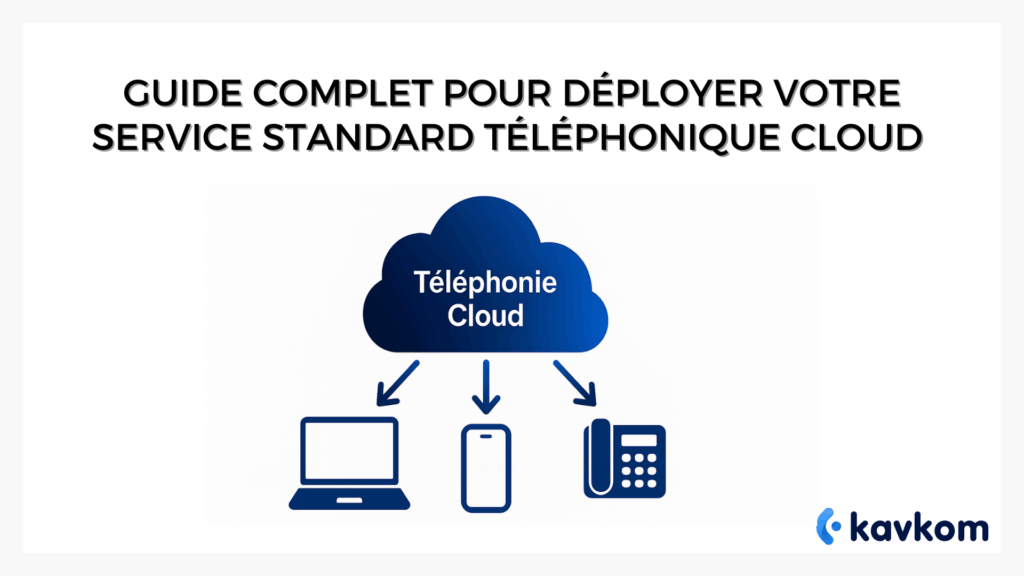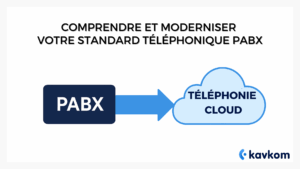A cloud switchboard like Kavkom lets you offer a smooth, professional first contact, without any hardware requirements, cabling or SIM cards – everything works directly from the Internet.
This guide will take you step by step through the process. You’ll discover what a virtual switchboardwhat a virtual switchboard is, why it’s the obvious choice for today’s businesses, and how to deploy one in five simple, effective steps.
Points to remember :
- A cloud switchboard replaces hardware installed on the premises with online call management.
- Employees can use the same number from the office, home or a cell phone.
- Moving to the cloud reduces installation and maintenance costs, replacing them with simple, flexible, no-commitment, pay-as-you-go billing.
- Integrated tools (dashboards, recordings, supervision) integrate directly with your existing CRM (HubSpot, Zoho, Salesforce, etc.) for complete call tracking.
- Studies show that cloud telephony offers stability equivalent to physical systems, while costing small businesses less over the long term.
What is a cloud switchboard service?
A cloud switchboard is an online hosted system that replaces the old physical PBX or IPBX. In concrete terms, it lets you manage incoming and outgoing calls from an interface accessible from any Internet-connected device.
It’s like a classic switchboard, but dematerialized. You’ll find all the features your teams are already familiar with:call transfer, music on hold, voicemail and queuing. The difference lies in its flexibility. There’s no need for cables or boxes – everything works thanks to VoIP.
Imagine an invisible conductor. The instruments are your computers, your IP phones and your mobiles. The cloud holds the baton. It synchronizes voices, distributes roles and allows each note to arrive at just the right moment.
A virtual switchboard is not just a modern alternative. It’s a new way of thinking about customer relations. You don’t just manage the calls: you build a smooth, professional and adaptable welcome to your real needs.
Setting up a cloud switchboard is like switching from an old paper diary to a shared mobile application. You gain in fluidity, flexibility and overview.
With a traditional system, every change often involves a technician, equipment and delays. With a virtual switchboard, you can customize your settings in just a few clicks. Your teams can work from the office, at home or even on the road, without losing touch with your customers.
Comparison
| Features | Traditional switchboard (PABX/IPBX) | Cloud switchboard |
|---|---|---|
| Installation | Expensive equipment, technician required | Quick activation, 100% online |
| Flexibility | Slow, limited changes | Instant set-up from the interface |
| Mobility | Stationary position required | Use on PC, cell phone or IP phone |
| Costs | High initial investment | No-obligation monthly subscription |
| Update | Regular maintenance | Automatic and included |
Adopting a cloud service also reinforces your company’sprofessional image. Smooth reception and responsive customer service inspire confidence.
Finally, the cloud model reduces financial risk. You only pay for what you need, with the option of suspending or adapting your lines. This flexibility suits in-house call center teams and SMEs alike – Kavkom provides the platform, not an outsourced service.
Publishers like Kavkom offer this type of service. Their strength lies in making telephony as simple as an Internet connection: rapid deployment, zero commitment, all business telephony functions included, with no hidden costs. Human support remains accessible at all times, removing a barrier often encountered with other players.
5 steps to a successful cloud switchboard rollout
Step 1: Prepare and assess your needs
Before choosing a cloud switchboard, take the time to define your expectations. How many employees will be handling incoming calls? Do you need a local, national or international number? Would you like to connect your telephony system to a CRM system to track call history?
A good starting point is to draw up a simple map of your current uses: telephone reception, transfers, queues, voicemail requirements. Then add your objectives: more mobility, better supervision, cost reduction.
Step 2: Choose your number and configure the interface
Choosing a telephone number is a strategic step. It’s not just a channel for receiving incoming calls: it’s also a showcase for your company. A local number inspires proximity. A national number conveys a broader image. An international number opens your doors to new markets.
Once you’ve chosen your number, it’s time to configure it. Everything is done via an easy-to-use online interface. You can define opening hours, personalize the greeting message, and direct calls to the right people.
These settings, once complex with a PABX, are now child’s play. In just a few clicks, you can set up a
Step 3: Integrate the solution with your CRM and IP phones
A cloud switchboard really comes into its own when linked to your business tools. Connected to your CRMit displays the customer record as soon as a call is received. Your teams save time, and your customers benefit from a more personalized welcome.
Integration with IP phones is just as simple. You can use a softphone on your computer or cell phone, or connect your VoIP-compatible physical phones directly. The difference with a
This interconnection transforms call management into a fluid flow. Your sales force no longer needs to juggle several tools: they can manage their exchanges from a single environment.
Step 4: Customize call management and supervision
A virtual switchboard does more than just receive and transfer calls. It also lets you personalize the customer experience. You can define queues, music or voice messages to be played outside business hours.
On the management side, you have access to supervision tools. Theinterface displays in real time the number of calls in progress, waiting times and the performance of each agent. You can even discreetly listen in on a conversation to train an employee or intervene if necessary.
These features turn the cloud standard into a management lever. You don’t just manage telephone lines you’re managing the quality of your day-to-day customer service.
Step 5: Optimize billing and adjust usage according to needs
Billing for a cloud switchboard is flexible. You pay a monthly or annual subscription fee, with no initial hardware investment. This reduces risk and gives you greater budget visibility.
The advantage is also adaptability. You can add or suspend lines according to your periods of activity. For example, a call center might increase the number of agents during a campaign, then return to lighter usage afterwards.
This flexibility reflects the reality of modern business. You retain control, without being bound by rigid contracts or hidden costs.
The operational and economic benefits of a virtual switchboard service
Adopting a virtual switchboard is more than just a technical convenience. It’s a way of transforming your communications into a real performance driver.
Immediate operational benefits
With a cloud switchboard, flexibility is instantaneous. You can manage incoming and outgoing calls from anywhere. Whether your teams are in the office, working from home or on the road, they’re always available and efficient. This mobility enhances the responsiveness of your customer service.
An academic study of VoIP in the cloud has shown that these systems offer stability equivalent to that of physical infrastructures, while benefiting from valuable elasticity: resources adjust automatically according to actual demand.
A measurable economic impact
The cloud eliminates the need for heavy investment in legacy systems. No need to buy or maintain a PBX. You pay a subscription based on your usage, with no hidden costs.
Research conducted at the University of Oregon shows that SMEs that migrate to a cloud switchboard reduce not only their initial costs, but also their total cost of ownership over several years. The study also notes a productivity gain: small structures no longer have to mobilize in-house resources to manage complex hardware.
Comparison
| Aspect | Old system (PABX/IPBX) | Cloud switchboards like Kavkom |
|---|---|---|
| Initial investment | High (equipment + installation) | No |
| Mobility | Stationary position required | Use on PC, mobile or IP phone |
| Maintenance | Regular visits by technicians | Automatic updates |
| Scalability | Slow, costly | Instant and adjustable |
| Total cost over several years | High (high TCO) | Reduced, flexible subscription |
This is exactly what Kavkom offers. Their model is based on pro rata billing and the possibility of suspending a line in the event of a drop in activity. Many companies see this as a practical way of reducing costs over the summer, while returning to full capacity in September.
By centralizing tools (real-time dashboards, telephone call records, CRM integrations), Kavkom also facilitates performance management. Every interaction becomes traceable, measurable and exploitable to improve the customer experience.
FAQ – Frequently asked questions about deploying a cloud switchboard service
What is a cloud switchboard service?
This is a virtual switchboard hosted online. It lets you manage incoming and outgoing calls via an Internet interface, without the need for cumbersome hardware.
Why adopt a cloud switchboard service rather than a traditional system?
A traditional system relies on a physical PABX or IPBX, which is costly and inflexible. The cloud model, on the other hand, offers greater flexibility, simple billing and greater mobility for your teams.
How can you effectively integrate a cloud switchboard service with CRM and IP phones?
Most vendors offer ready-to-use integrations. You can connect your switchboard to a CRM such as HubSpot or Salesforce, and use it on IP phones or via a softphone.
What are the main steps involved in deploying a cloud switchboard service?
All you need to do is follow five steps: assess your needs, choose a phone number, configure the interface, integrate your tools, customize call management, then adjust billing to suit your usage.
Conclusion
Deploying a cloud switchboard is no longer a technical project reserved for large companies. It’s simple, accessible and strategic. You’ll gain in flexibility, reduce your costs and improve your customers’ experience from their very first phone call.
Players like Kavkom are showing that this transformation can be achieved quickly, without commitment, with end-to-end human support. For a company, it’s an opportunity to transform its telephone answering service into a real lever of trust and growth.
A virtual switchboard isn’t just a modern alternative: it’s a new state of mind. It turns every call into an opportunity to forge links and strengthen your professional image.





